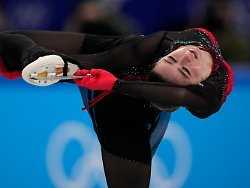CAS publishes details
That’s in Valiyeva’s doping document
02/17/2022, 11:55 p.m
The fact that Kamila Valiewa is even allowed to run in the Olympic singles is due to the International Court of Arbitration for Sport CAS. This allows the figure skater to start despite a positive doping test. The excitement is huge. Now there are details about the case of the 15-year-old Russian.
The Court of Arbitration for Sport CAS has published the substantiated arbitral award in the case of Kamila Valiyeva, bringing some details to light. According to the 41-page document, the concentration of the banned substance trimetazidine found in the Russian figure skater was 2.1 ng/ml. This is a low value, which Valiyeva’s representatives explained with the now famous grandfather thesis.
The mother of the athlete testified before the CAS that Kamila Valiyeva is regularly driven and picked up by her grandfather for daily training. He also often stays with the 15-year-old during the lunch break between two sessions. A video recording was also shown during the hearing, which the attorney said was made by the Athlete’s grandfather. The pictures show a pack of “Trimetazidin MV” in the grandfather’s car.
Valiyeva’s lawyers also presented a medical expert named Andrei Sholinsky. He explained that trimetazidine requires a prescription, is forbidden for children and can cause side effects such as dizziness and impaired balance. He thinks it is possible that it was taken up by contamination.
A second medical expert named Eduard Besuglow referred to a study of trimetazidine use among Polish athletes. Accordingly, a single intake of a dose of 35 mg in a doping test the next day leads to a value of around 1000 to 9000 ng/ml. A concentration of 2.1 ng/ml, as with Valiyeva, would speak for a single application about five to seven days before sampling.
Hair analysis could provide information
In an interview with ARD, Cologne doping expert Mario Thevis suggested carrying out a hair analysis on the young Russian. “With the analysis, one can possibly distinguish very well whether it was a matter of repeated intake in larger quantities or an accidental single dose,” said Thevis.
The banned metabolism modulator trimetazidine was discovered in a sample taken by Valiyeva on December 25. The sample arrived at the control laboratory in Stockholm on December 29, according to the CAS ruling. Apparently due to corona cases, it was not evaluated by the inspectors until February 8th – one day after the Russian Olympic Committee’s victory for Valiyeva in the team competition.
After some legal hiccups and objections from the International Olympic Committee (IOC) and the World Anti-Doping Agency WADA, among others, the CAS issued Valiyeva the conditional start permit for the individual competition on Monday. Valiewa finished the short program on Tuesday in first place, but after Thursday’s free program with numerous mistakes, she dropped back to fourth place.
